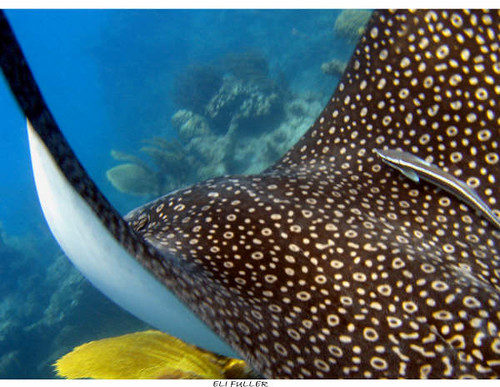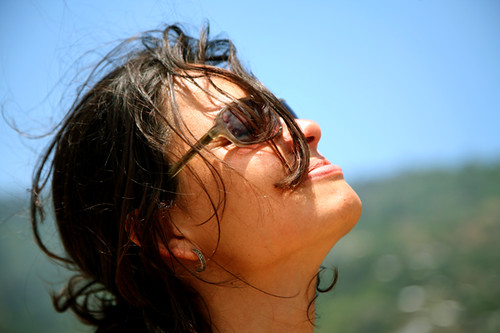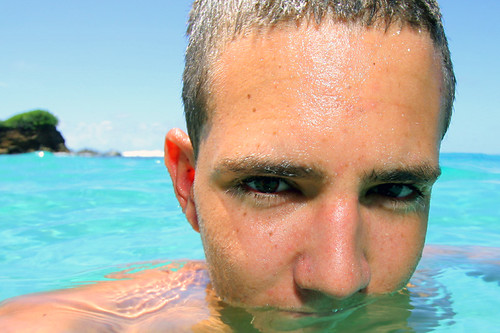Yesterday one of my firends posted the video below on their facebook wall and I was curious to see what it was about. It reminded me about a blog post i wrote back in the summer of 2007 which received a huge amount of interest and hits. Since this info is so important I figured I would re-post it which is something i rarely do on my blog. The video below is good enough that it inspired me to share it and my most popular blog post from the summer of 07. Sharks are not the most dangerous things you will find here.
Ever since I can remember, our visitors have been asking questions about dangerous things that you may meet while out on the water. I started competing in regional windsurfing events when I was twelve and that was after years already spent out fishing and messing about on small boats. So many people would worry about sharks and other “nasties” out there in the unknown.
 When I started my tour company Adventure Antigua the questions or worries were even more common about “nasties” in the sea. People would ask about sharks and jellyfish, stingrays, moray eels, barracuda, fire coral, urchins, currents, waves, pirates, poisonous plants…and the list keeps going on an on. You name the worry and I have heard of it or been asked about it. The Italian guests that visit Antigua seem to be the biggest worriers with “squalo?” and “medusa?” being words that I learned very quickly through constant repetition. When working in this business you sometimes are challenged to reply to common questions in different ways just to keep it interesting and not annoying. I know that if you had to answer the same squalo question every week in the same way, you would get tired pretty quick. I mean how would you answer the question; “Do you have sharks in Antigua?”
When I started my tour company Adventure Antigua the questions or worries were even more common about “nasties” in the sea. People would ask about sharks and jellyfish, stingrays, moray eels, barracuda, fire coral, urchins, currents, waves, pirates, poisonous plants…and the list keeps going on an on. You name the worry and I have heard of it or been asked about it. The Italian guests that visit Antigua seem to be the biggest worriers with “squalo?” and “medusa?” being words that I learned very quickly through constant repetition. When working in this business you sometimes are challenged to reply to common questions in different ways just to keep it interesting and not annoying. I know that if you had to answer the same squalo question every week in the same way, you would get tired pretty quick. I mean how would you answer the question; “Do you have sharks in Antigua?” I have at least 10 versions of answers to that one just so the crew doesn’t get annoyed with the same answer each day. One of them may be silly like “there are loads of sharks, but they are all walking around on two legs in St. Johns.” The answer could be more serious like… “Yes, but there has never been a shark attack in Antigua’s recorded history.”
I have at least 10 versions of answers to that one just so the crew doesn’t get annoyed with the same answer each day. One of them may be silly like “there are loads of sharks, but they are all walking around on two legs in St. Johns.” The answer could be more serious like… “Yes, but there has never been a shark attack in Antigua’s recorded history.”
Most of the time if someone is asking about unknown nasties that may attack them and ruin their eco tour or xtreme tour…I tell them that the most dangerous thing that they will encounter today is the sunshine.
 It’s not a joke at all and is the core of today’s blog. Each year in the USA over one million people get skin cancer with over eight thousand deaths a year because of the disease. This crazy statistic is something that worrys me more than any thoughts of the other “nasties” that i may encounter while out on the boat. In the USA there are on average 60 shark attacks a year with 4 being fatal. Antigua gets none. In fact most of the Caribbean is shark attack free. With over 8000 dead with skin cancer and 4 from shark attacks you can see what the main “nasty” is.
It’s not a joke at all and is the core of today’s blog. Each year in the USA over one million people get skin cancer with over eight thousand deaths a year because of the disease. This crazy statistic is something that worrys me more than any thoughts of the other “nasties” that i may encounter while out on the boat. In the USA there are on average 60 shark attacks a year with 4 being fatal. Antigua gets none. In fact most of the Caribbean is shark attack free. With over 8000 dead with skin cancer and 4 from shark attacks you can see what the main “nasty” is.
This past week the USA has finally followed Europe’s lead when it comes to sunscreen regulations. Apparently the actual new classification and labeling of sunscreens which is the same that they have in England and in Europe will not come into effect until 2009. I don’t know why it’s going to take so long to show people that their sunscreen isn’t protecting them against possible skin cancer death, but at least the new labels will come in 2009. Europe and Canada has been using it since 1993. If you live in the USA now I guess you can always just remember a few things spoken about on this blog when buying sunscreen.
For a long time it was mistakenly thought that UVB rays were the harmful rays radiated from our sun which is why the SPF classification came into being. The FDA used the SPF as a measure to show how well you were being protected against these harmful UVB rays which undoubtedly can cause skin cancer. Anyway, long after many studies proved that the other UVA rays are also dangerous and can cause skin cancer the FDA has decided that they should let the general public know. The new classification will have the SPF rating as well as the UVA rating which will be a 5 star rating system like Europe’s system. A great article on it all is: http://www.nytimes.com/2007/08/24/health/24sunscreen.html?ref=health
I think if you really want to be a geek (aka “smart”) you could check the chemicals that are in your sunscreen. In order to block both UVA and UVB sun rays there are certain ingredients that you should look for in your high SPF factor sunscreen keeping in mind that the SPF by itself is just blocking the UVB rays. These UVA blocking chemicals are avobenzone (also called Parsol 1789), titanium dioxide, zinc oxide, or Mexoryl SX (or Tinosorb outside the U.S.).
 Now I am no scientist so I don’t know which of these chemicals are better for you than the other, but there are loads of articles on the net that you can research the topic more. I know that many people think that some of these chemicals may do more harm than good. A good start explaining the benefits is found on this link where i took the quote below from: http://www.consumersearch.com/www/family/sunscreen/index.html#intro :
Now I am no scientist so I don’t know which of these chemicals are better for you than the other, but there are loads of articles on the net that you can research the topic more. I know that many people think that some of these chemicals may do more harm than good. A good start explaining the benefits is found on this link where i took the quote below from: http://www.consumersearch.com/www/family/sunscreen/index.html#intro :
“Dermatologists say that Mexoryl SX is the most effective UVA-blocking ingredient currently available. It has been used in Canada and Europe since 1993, but was just approved by the FDA for use in the U.S. in July 2006. However, sunscreen products containing Mexoryl SX (a trademark of L’Oreal) have been slow to enter the U.S. market. Right now, only a handful of products are available containing Mexoryl in the U.S. LaRoche-Posay Anthelios SX (*est. $30 for 3.4 ounces) is a facial moisturizer that contains Mexoryl SX. More widely available is Lancôme UV Expert 20 (*est. $35 for 3.4 ounces), a face and body lotion with Mexoryl SX. If you want the best possible protection, Lancôme UV Expert 20 an ideal mix of ingredients, but it’s very expensive.
Helioplex is another advance in sun protection. Developed by Neutrogena, Helioplex boosts the UVA-blocking power of avobenzone, which otherwise begins to degrade after a couple of hours. (Mexoryl SX doesn’t degrade in sunlight — another reason why reviews say it’s such a good ingredient.) There are actually two kinds of UVA rays — short and long waves. Avobenzone protects against long-wave rays. Several ingredients, including the commonly used oxybenzone, can protect against short-wave UVA rays. Many sunscreens contain oxybenzone, but don’t contain anything to protect against long-wave UVA. By including oxybenzone, companies are allowed to say their product protects against UVA, but unless it also contains avobenzone, zinc oxide, titanium dioxide or Mexoryl SX, you are not protected against long-wave UVA rays. That’s why skin-care experts say you should look for “broad spectrum” UVA and UVB protection. “
 You want to find high factor, broad spectrum UVA and UVB sunscreens that say something like “all day waterproof” or even “6 hour waterproof”. This is where I think the USA does a better job that the UK. Most of the UK stuff washes off as soon as you get in the sea and unless you are always putting the stuff back on you will get burnt.
You want to find high factor, broad spectrum UVA and UVB sunscreens that say something like “all day waterproof” or even “6 hour waterproof”. This is where I think the USA does a better job that the UK. Most of the UK stuff washes off as soon as you get in the sea and unless you are always putting the stuff back on you will get burnt. My sunscreen of choice for years has been Bullfrog since I can put it on once in the morning as I am leaving the harbour and that’s it for the day. The stuff stays on after loads of snorkeling too. Epicurean in Jolly Harbour has it for sale.
My sunscreen of choice for years has been Bullfrog since I can put it on once in the morning as I am leaving the harbour and that’s it for the day. The stuff stays on after loads of snorkeling too. Epicurean in Jolly Harbour has it for sale. There are more and more waterproof sunscreens on the market and recently someone left us some Coppertone kids 50 waterproof spray which is so good that I think you only need to apply it once a holiday!! My mom and brother have had more serious skin cancers than I have had and it’s no joke at all. Buy the right stuff and put it on. Even the people with nice dark skin can get skin cancer so be prepared. It’s a lovely place to be and it can be safe with the right preparations. I think that good education about sharks, stingrays and the same sunshine that many ancient civilizations (who are no longer with us) have worshiped is key to a happy trip to Antigua and the Caribbean. I hope you enjoyed the words or at least my photos. c ya!
There are more and more waterproof sunscreens on the market and recently someone left us some Coppertone kids 50 waterproof spray which is so good that I think you only need to apply it once a holiday!! My mom and brother have had more serious skin cancers than I have had and it’s no joke at all. Buy the right stuff and put it on. Even the people with nice dark skin can get skin cancer so be prepared. It’s a lovely place to be and it can be safe with the right preparations. I think that good education about sharks, stingrays and the same sunshine that many ancient civilizations (who are no longer with us) have worshiped is key to a happy trip to Antigua and the Caribbean. I hope you enjoyed the words or at least my photos. c ya!
